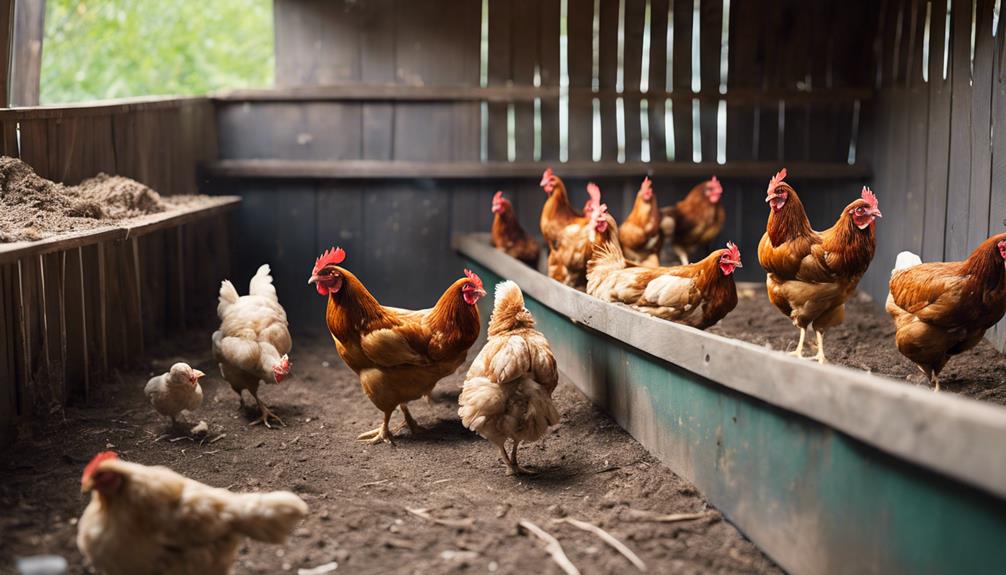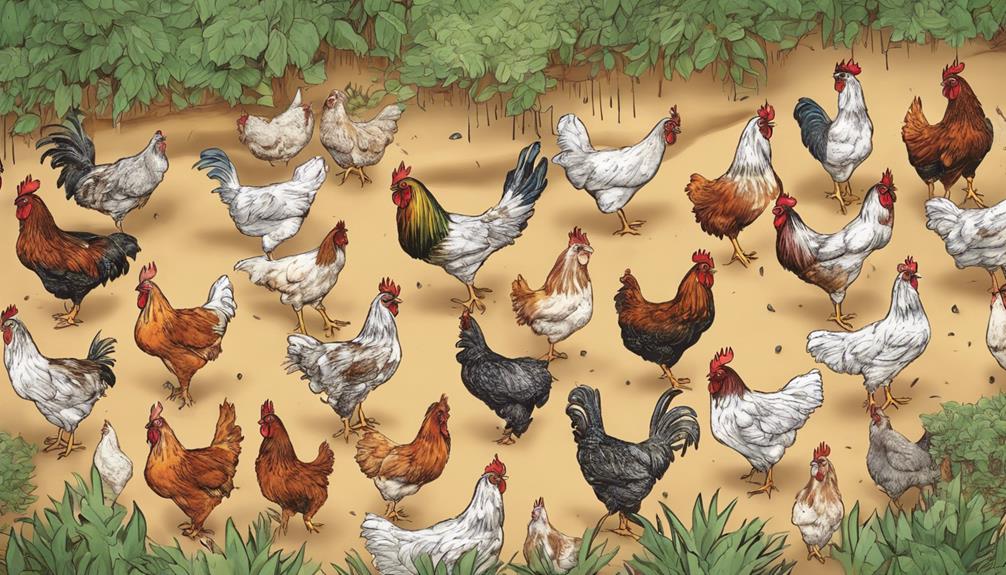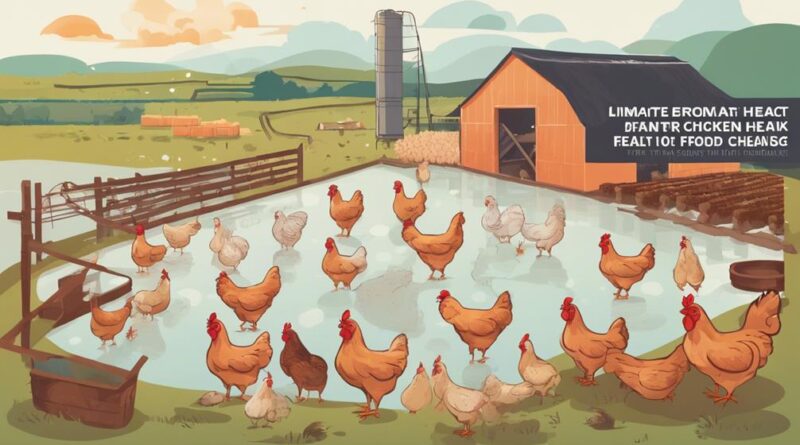Top 10 Climate Change Impacts on Chicken Health"
Climate change significantly affects chicken health: heat stress hampers egg production, genetic selection impacts heat tolerance, and cooling is vital. Disease patterns shift with temperatures, controlled by proper techniques and early detection. Water scarcity demands efficient irrigation and drought strategies. Altered feed quality leads to growth issues and immunity compromise. Extreme weather preparation is key, along with genetic resilience. Air quality control is crucial for dust and waste management. Parasite control and nutritional deficiencies are tackled with biosecurity and adaptation. Biodiversity loss reduces adaptability and resilience. Economic sustainability relies on market demand and resource efficiency. Explore more on these impactful climate change effects.
Increased Heat Stress
Experiencing prolonged exposure to high temperatures can significantly impact the health and welfare of chickens by exacerbating heat stress-related challenges. Chickens are particularly vulnerable to heat stress due to their limited ability to cool down efficiently. Heat stress can lead to decreased feed intake, reduced egg production, impaired growth, and even mortality in severe cases.
Heat adaptation mechanisms play a crucial role in helping chickens cope with high temperatures. Chickens can adapt to heat stress by increasing their water consumption, seeking shade, and altering their behavior to reduce heat absorption. Additionally, certain chicken breeds are more heat-tolerant than others, emphasizing the importance of genetic selection in improving heat resilience.
Implementing effective cooling measures is essential in mitigating the impact of heat stress on chickens. Providing adequate ventilation in poultry houses, using fans or evaporative cooling systems, and ensuring access to cool, fresh water are key strategies to help chickens maintain a comfortable body temperature. Farmers must also be vigilant in monitoring heat stress indicators, such as panting, wing spreading, and reduced activity, to intervene promptly and prevent heat-related complications.
Changing Disease Patterns
With the changing climate, there's a noticeable shift in disease patterns affecting chicken populations worldwide. The evolving disease dynamics are a result of various factors influenced by climate change. As temperatures rise, pathogens that were once limited to certain geographical areas are now spreading to new regions. This expansion exposes chicken populations to diseases they may not have encountered before, increasing susceptibility and mortality rates.
To combat these changing disease patterns, chicken farmers are implementing innovative temperature regulation techniques. Maintaining optimal temperatures in chicken coops is crucial for reducing stress on the birds' immune systems, making them less susceptible to diseases. Ventilation systems, cooling pads, and proper insulation are being utilized to ensure chickens are kept in a comfortable and healthy environment.
Furthermore, as diseases adapt to new environmental conditions, farmers must stay vigilant and regularly monitor their flocks for any signs of illness. Early detection is key in preventing disease outbreaks that can decimate chicken populations. By staying informed about evolving disease dynamics and implementing effective temperature regulation techniques, chicken farmers can better protect the health and well-being of their flocks in the face of changing climate conditions.
Water Scarcity Challenges
Amidst the challenges posed by climate change, the poultry industry faces significant obstacles due to water scarcity affecting chicken health and production. Water scarcity not only impacts the availability of drinking water for chickens but also affects crop production for feed, leading to nutritional deficiencies and stress on the birds.
Here are three crucial aspects to consider in combating the water scarcity challenges:
- Irrigation Solutions: Implementing efficient irrigation systems such as drip irrigation or sprinkler systems can help conserve water and ensure that crops grown for chicken feed receive an adequate water supply. By optimizing irrigation practices, water usage can be minimized, reducing the overall impact of water scarcity on chicken health.
- Drought Management: Developing robust drought management strategies is essential for mitigating the effects of water scarcity on chicken farming. This may involve water storage solutions, such as rainwater harvesting or constructing reservoirs, to ensure a stable water supply during periods of drought. Additionally, utilizing drought-resistant crop varieties can help maintain feed production levels even in challenging water conditions.
- Monitoring and Adaptation: Regular monitoring of water sources, crop conditions, and chicken health is crucial for early detection of water scarcity-related issues. By staying vigilant and adapting management practices in response to changing water availability, poultry farmers can proactively safeguard the well-being of their chickens and maintain sustainable production levels despite water scarcity challenges.
Feed Quality Alterations
Facing the challenge of water scarcity in the poultry industry, the quality of feed provided to chickens undergoes significant alterations impacting their health and production efficiency. These changes in feed quality can have a profound impact on nutrient absorption and growth performance in chickens.
The altered feed quality due to climate change can lead to variations in nutrient composition, affecting the overall health and development of chickens. Changes in the availability of certain nutrients crucial for growth and immunity can impair the chickens' ability to thrive. This can result in reduced growth rates, lower egg production, and compromised immune responses.
Moreover, fluctuations in feed quality can also impact nutrient absorption in chickens. Essential nutrients may not be absorbed efficiently, leading to deficiencies that can further exacerbate health issues and hinder optimal growth performance. Poor nutrient absorption can weaken chickens, making them more susceptible to diseases and decreasing their overall productivity.
Extreme Weather Events
Extreme weather events, such as heatwaves, storms, and floods, disrupt the environmental conditions crucial for maintaining chicken health and welfare in the poultry industry. These events can lead to increased stress and susceptibility to diseases among chicken populations due to sudden and extreme changes in temperature, humidity, and air quality.
Here are three key factors to consider when addressing extreme weather events in poultry farming:
- Emergency preparedness: Establishing comprehensive emergency plans is essential to minimize the impact of extreme weather events on chicken health. This includes having protocols in place for evacuating birds to safer locations, ensuring access to clean water and food during emergencies, and implementing measures to maintain optimal temperatures within poultry houses.
- Genetic resilience: Breeding chicken breeds with a focus on genetic resilience to withstand varying environmental conditions is crucial in mitigating the effects of extreme weather events. Selecting for traits such as heat tolerance, disease resistance, and adaptability can help improve the overall resilience of chicken flocks to climate-related challenges.
- Environmental monitoring: Regular monitoring of environmental parameters such as temperature, humidity, and air quality can provide early warning signs of impending extreme weather events. By staying vigilant and proactive in monitoring these factors, poultry farmers can take timely action to protect the health and well-being of their chicken populations.
Air Quality Issues
The quality of air in poultry farming environments is a critical factor impacting chicken health and productivity. Proper ventilation solutions are essential to maintain good air quality. Inadequate ventilation can lead to the buildup of harmful gases like ammonia and carbon dioxide, which can negatively affect respiratory health and overall well-being of chickens. Implementing biosecurity measures is crucial in preventing the entry of pathogens that could further degrade air quality.
Respiratory health is particularly vulnerable to poor air quality in poultry farms. Dust, endotoxins, and ammonia are common airborne pollutants that can irritate the respiratory tract, leading to conditions such as respiratory distress syndrome and chronic respiratory diseases. It's vital to adopt farming practices that minimize the release of these pollutants into the air. Regular cleaning of facilities, proper waste management, and using dust control measures are effective strategies to improve air quality and promote respiratory health in chickens.
Investing in quality ventilation systems, such as fans and air exchange units, can significantly enhance air circulation and reduce the concentration of harmful gases. Monitoring air quality parameters regularly is essential to ensure that chickens are raised in a healthy environment. By prioritizing air quality management through ventilation solutions and biosecurity measures, poultry farmers can safeguard the respiratory health and overall well-being of their flocks, ultimately improving productivity and profitability.
Poultry Parasite Proliferation

Parasites pose a significant threat to poultry health and productivity, necessitating proactive management strategies to prevent their proliferation. Poultry parasite control is crucial for maintaining flock health and ensuring optimal production. Here are three key points to consider when addressing poultry parasite proliferation:
- Impact of Climate Change: Climate change can influence the distribution and prevalence of poultry parasites. Rising temperatures and increased humidity create more favorable conditions for parasites to thrive, leading to higher infection rates among poultry flocks. It's essential to adapt parasite control measures to changing environmental conditions to mitigate the impact of climate change on parasite proliferation.
- Resistant Parasite Strains: Over-reliance on certain parasiticides can contribute to the development of resistant parasite strains. Effective resistance management strategies, such as rotating classes of anthelmintics and implementing integrated parasite control programs, are essential to combatting resistance development. Monitoring parasite populations for signs of resistance and adjusting control methods accordingly are critical for maintaining parasite control efficacy.
- Biosecurity Measures: Implementing stringent biosecurity measures is crucial for preventing the introduction and spread of parasites within poultry facilities. Proper sanitation practices, quarantine protocols for new birds, and controlling wild bird access can help reduce the risk of parasite transmission. Combining biosecurity measures with effective parasite control strategies is key to managing poultry parasite proliferation and safeguarding flock health.
Nutritional Deficiencies
Nutritional deficiencies in poultry can significantly impact overall health and productivity, necessitating precise dietary management strategies for optimal flock performance. When chickens experience inadequate nutrient intake, various health issues can arise, affecting their growth and immune system function. Growth retardation is a common consequence of nutritional deficiencies, leading to decreased body weight gain and delayed development in chickens. Furthermore, inadequate nutrition can result in immune suppression, making chickens more susceptible to infections and diseases.
Eggshell quality and bone density are also crucial aspects affected by nutritional deficiencies in chickens. Calcium, for example, plays a vital role in the formation of strong eggshells. A deficiency in calcium can lead to thin or brittle eggshells, impacting egg quality and hatchability rates. Similarly, inadequate levels of calcium and other essential minerals can compromise bone density in chickens, increasing the risk of skeletal deformities and fractures.
To mitigate the impact of nutritional deficiencies on chicken health, it's essential to provide a well-balanced diet that meets all their nutritional requirements. Regular monitoring of nutrient levels in feed and supplements can help ensure that chickens receive adequate amounts of essential nutrients for optimal growth, immune function, egg production, and skeletal health. By addressing nutritional deficiencies proactively, poultry farmers can promote the overall well-being and performance of their flocks.
Loss of Biodiversity Impact

Amidst the intricate web of ecosystems in which chickens thrive, the impact of loss of biodiversity reverberates through their health and well-being. When biodiversity is compromised, chickens face several significant challenges:
- Habitat Fragmentation: As habitats become fragmented due to human activities or natural disasters, chickens lose access to diverse foraging areas, nesting sites, and protective cover. This loss disrupts their natural behaviors and can lead to increased stress levels and susceptibility to diseases.
- Genetic Diversity Decline: Species extinction and habitat destruction contribute to a reduction in genetic diversity among chicken populations. Limited genetic variability diminishes the ability of chickens to adapt to changing environmental conditions and makes them more vulnerable to infectious diseases and other health issues.
- Ecosystem Resilience: The decline in biodiversity not only affects chickens directly but also impacts the overall resilience of ecosystems. Chickens rely on a healthy and balanced ecosystem for food sources, disease control, and habitat stability. When biodiversity diminishes, these ecosystem services become compromised, further jeopardizing the well-being of chickens.
Economic Sustainability Concerns
The economic sustainability of chicken farming is intricately linked to various factors such as production costs, market demand, and resource management practices. Economic factors play a crucial role in determining the profitability and long-term viability of chicken farms. Rising production costs, including feed, energy, and labor expenses, can significantly impact the financial health of poultry operations. Farmers must carefully monitor and manage these costs to ensure economic sustainability.
Market demand also influences the economic sustainability of chicken farming. Fluctuations in consumer preferences, trade policies, and global market conditions can affect the demand for poultry products. Farmers need to stay informed about market trends and adjust their production levels accordingly to meet consumer needs while maximizing profits.
Implementing sustainability practices is essential for the economic viability of chicken farming in the face of climate change. Adopting environmentally friendly technologies, improving resource efficiency, and reducing waste can't only reduce production costs but also enhance the resilience of chicken farms to changing environmental conditions. By investing in sustainable practices, farmers can mitigate the financial risks associated with climate change and contribute to the long-term economic sustainability of the poultry industry.
Frequently Asked Questions
How Can Chicken Farmers Adapt to Water Scarcity Challenges?
To adapt to water scarcity challenges, you can implement rainwater harvesting to collect and store rain for irrigation. Consider using drip irrigation systems to efficiently deliver water to your crops while minimizing waste.
These techniques can help you conserve water, manage drought conditions, and ensure your chickens have access to sufficient water for their health and well-being. Experiment with these methods to optimize water usage on your farm.
What Are the Long-Term Effects of Air Quality Issues on Chicken Health?
When air quality issues worsen due to pollution from climate change, chicken health can suffer long-term. Respiratory diseases become more prevalent in chickens exposed to poor air quality. Pollution can irritate their respiratory systems, leading to chronic issues.
Understanding the impact of air quality on chicken health is crucial for mitigating long-term effects. Monitoring and improving air quality near chicken farms is essential to safeguarding their well-being amid changing environmental conditions.
How Do Extreme Weather Events Impact Chicken Production?
When extreme weather events strike, like heatwaves or hurricanes, they can have detrimental effects on chicken production. Heat stress can lead to increased mortality rates among chickens.
These events can also disrupt the supply chain, causing feed shortages which may result in malnutrition and susceptibility to diseases. Overall, extreme weather events pose significant challenges to maintaining optimal chicken health and production levels.
What Measures Can Be Taken to Prevent Poultry Parasite Proliferation?
To prevent poultry parasite proliferation, consider natural remedies like essential oils or herbal supplements. Implement biosecurity measures such as strict sanitation protocols and controlled access to the coop.
Rotate grazing areas regularly to reduce parasite buildup. Chemical treatments can also be used under veterinary guidance.
What Strategies Promote Economic Sustainability in Chicken Farming?
To enhance economic sustainability in chicken farming, focus on cost efficiency by optimizing feed conversion ratios and reducing energy consumption. Stay informed about market trends to adapt production accordingly, maximizing profitability.
Utilize technological advancements in monitoring and automation to streamline operations. Implement strategic marketing plans to reach target consumers effectively.
Conclusion
In conclusion, the top 10 climate change impacts on chicken health present significant challenges for the poultry industry. From increased heat stress and changing disease patterns to water scarcity and feed quality alterations, these factors can have detrimental effects on chicken well-being and productivity.
It's crucial for researchers, farmers, and policymakers to address these issues proactively to ensure the sustainability and resilience of chicken production in the face of a changing climate.
